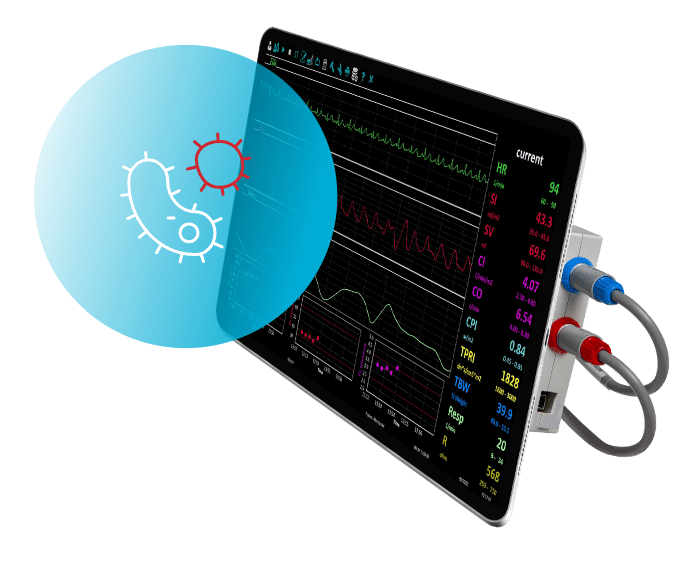Skilled Nursing Facilities
The NICaS non-invasive hemodynamic system enables the decision maker (treating physician, NP, RN) to manage each patient with the help of a personal and comprehensive hemodynamic profile (information otherwise only available in high level hospital care) and continuously balance the patient via drug titration.
Challenges
Determining the different causes of acute or chronic hemodynamic instability.
Reducing the high readmission rates that cause revenue losses and star rating decreases.
Viewing trends in the hemodynamic status throughout the patient’s treatment.
Solutions
Better patient treatment: portable, safe, accurate and accessible hemodynamic monitoring.
Remote management: Cloud based central management platform allowing connection to EMR and remote analysis by specialists.
Our clients report a 60.5% cut in all cause related readmissions and 98% for CHF.
Balancing the patient via drug titration will yield a substantial reduction in the patient readmission rates and thus significantly reduces revenue loss and deterioration of the star rating. Moreover, NICaS unique cloud-based central management platform, designed specifically for the SNF operational needs, enables the medical team to review/manage the NICaS hemodynamic data from one location, using a single provider.
SNF In Numbers:
24.9% – The average readmission rate to a SNF.
36% of skilled nursing facilities saw a drop in their star rating in 2019.
$400k – Is the average amount that SNFs lose per year due to HF readmissions

Related Clinical Markets
Related Clinical Studies
Utility of NICaS Non-Invasive Hemodynamic Monitoring in Critically Ill Patients with COVID-19
Authors: Wisam Zabeeda, Jonah Benjamin Cohen, Anat Reiner Benaim, Shiri Zarour, Yael Lichter, Idit Matot, Or Goren Conclusion: Non-invasive hemodynamic monitoring via the NICaS device
The Impact of Positive Inotropic Therapy on Hemodynamics and Organ Function in Acute Heart Failure: A Differentiated View
Authors: Juan Cheko, Nikolaos Patsalis, Julian Kreutz, Dimitar Divchev, Georgios Chatzis, Bernhard Schieffer, Birgit Markus Conclusion: Patients with acute decompensated HF benefit from positive inotropic
Comparing elective and emergency caesarean section by using bioimpedance method
Authors: Zuhal Çavuş, Ayşe Vahapoğlu, Ülkü Aygen Türkmen, Fatma Ketenci Gencer, Elif Yıldız Conclusion: Understanding normal hemodynamic values before, during, and after C/S is feasible
Noninvasive Hemodynamic Evaluation Following TAVI for Severe Aortic Stenosis
Authors: Tzlil Grinberg, Yaron Aviv, Mordehay Vaturi, Leor Perl, Maya Wiessman, Hanna Vaknin-Assa, Pablo Codner, Yaron Shapira, Ran Kornowski, Katia Orvin Conclusion: Unique short‐term adaptive
Correlation of Impedance Cardiography-Derived and Cardiac Magnetic Resonance-Derived Stroke Volumes
Authors: Pedram Hassan-Tash, Umar Ismail, Iain D C Kirkpatrick, Amir Ravandi, Davinder S Jassal, Brett Hiebert, Malek Kass, Richard A Krasuski, Ashish H Shah Conclusion:
Non-invasive hemodynamic profiling of patients undergoing hemodialysis-a multicenter observational cohort study
Authors: Keren Doenyas-Barak, Marcia H. F. G. de Abreu, Lucas E. Borges, David Pereg, Ilya Litovchik, Shmuel Fuchs and Sa’ar Minha Conclusion: Non-invasive assessment of
The value of non-invasive measurement of cardiac output and total peripheral resistance to categorize significant changes of intradialytic blood pressure: a prospective study
Authors: Yunlin Feng, Yurong Zou, Yifei Zheng, Nathan W Levin, Li Wang Conclusion: This technology provides multi-dimensional insight into intradialytic hemodynamic parameters, which may be
Bioimpedance based clinical decision making in hemodialysis patients decreases episodes of hypotension
Authors: Katzir, Zeev; Petrohno, Oksana; Leiba, Adi; Sharipov, Tatiana; Rubin, Olga; Gaber, Yahya; Hausman, Michel Conclusion: These preliminary results suggest that clinical decision-making based on
Directed antihypertensive therapy improves growth restriction and perinatal mortality in women with chronic hypertension.
Authors: David Chaffin, Jesse Cottrell, Kelly Cummings, David Jude. Maternal Hypertension Center at Cabell Huntington Hospital, Virginia, USA Conclusion: Impedance cardiography-directed antihypertensive therapy during early
